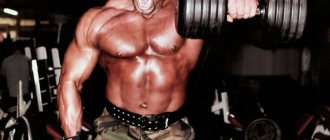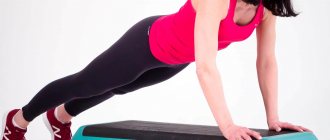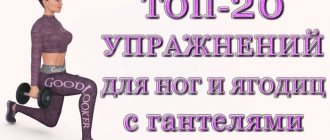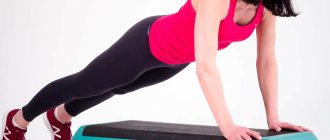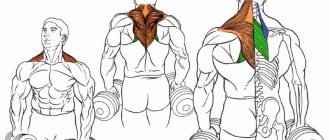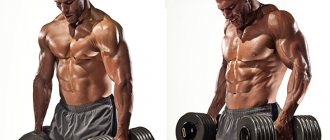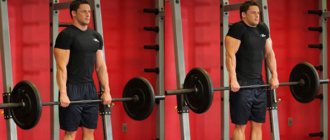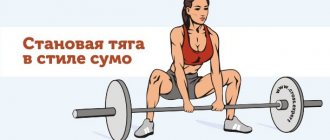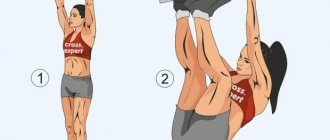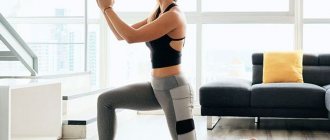Thrusters are one of the CrossFit exercises; in the classic version, the exercise is performed with a barbell. This is a specific exercise that consists of squats and crunches. Its specificity is that the barbell press is not performed concentratedly, but by inertia, as if by “throwing out”. Not all beginners can master the thruster technique from scratch. And for this there is a simplified version with dumbbells, which we will consider today.
Features of thrusters with dumbbells
The exercise helps to engage most muscle groups, both lower and upper body. All this happens thanks to the simultaneous performance of squats and push-ups. Its peculiarity is that the joints of the hands are in a safer position, without being subjected to heavy load, as when performing the option with a barbell.
For those who are just mastering the thruster technique and also experience discomfort when performing the version with a broken hand, the option with dumbbells is more suitable. Another feature of the exercise is that the second part of the movement, that is, the swing, is not performed concentratedly, like a standing dumbbell press, but with the help of a throw, that is, an impulse is created when the body is extended, and the dumbbells are thrown up. This greatly lightens the weight of the load when lifting.
What are thrusters and how to make them?
Let's start with the fact that “thruster” is translated as “ejection”. The exercise consists of two parts: squats and throwing the barbell above you. By combining two movements, the effect on the muscles will be more complex. Thrusters can be done with different equipment - dumbbells, body bars or medicine balls, but the classic version of the exercise is with a barbell.
Technique:
- We place our feet shoulder-width apart. Arms bent at the elbows, holding the barbell in front of the chest;
- perform a deep squat;
- from this position we sharply push ourselves upward. At the moment of lifting, we throw the barbell over our heads.
- then we lower the barbell back to the chest and return to a deep squat.
Elena Skoblova
supervisor and master trainer of the World Class gym
The exercise came to CrossFit from weightlifting. Due to the complex effect on all muscle groups, it is suitable specifically for the development of strength indicators. You can’t create relief with it, but you can significantly develop strength and endurance. In addition, it is extremely energy-consuming, so thrusters will also help you lose weight.
Photo: istockphoto.com
Technique for performing thrusters with dumbbells
- Take dumbbells in both hands, place your feet slightly wider than your pelvis, with your toes pointed apart.
- Place the dumbbells at your shoulders, holding them with a parallel grip, lower your elbows to the floor.
- As you inhale, squat deeply, lowering your pelvis just below your knees.
- As you exhale, straighten your torso and throw the dumbbells up from the middle of the amplitude.
- At the top point of the movement, the entire body forms a straight line. The dumbbells are positioned clearly above the shoulder joints.
- Lower your arms to shoulder level and at the same time squat while inhaling.
- Repeat the movement.
What muscles work in the exercise
Basic thrusters exercise.
It involves the movement of most of the large joints, namely the knee, hip, ankle, shoulder and elbow. As a result, almost all major muscle groups of the body are included in the work. Among them:
- Quadriceps, hamstrings and gluteal muscles are maximally loaded in the first part of the movement, when squats
- The calves receive a static load and act as stabilizers of the body in an upright position.
- The rectus abdominis and psoas muscles are actively involved throughout the entire exercise, as the main stabilizers of the torso
- The latissimus dorsi and trapezius muscles work in a static mode, helping the lower back to keep the back straight
- The shoulders, biceps and triceps perform the main load in the second phase of the movement. The biceps help lift the dumbbells to shoulder level, while the deltoids and triceps push the weight overhead
- The forearms work in a static mode, holding the projectile
Common mistakes in squats with dumbbell releases
- The body weight is transferred to the socks. When performing thrusters, like classic squats, the body weight should always be distributed more towards the heels.
- When performing squats, the back is strongly rounded. For many, holding dumbbells in their hands provokes excessive torso tilt or rounding of the back. This is a serious violation that can cause serious injury. Therefore, it is important to monitor the spine, especially in exercises that are performed for a while.
- The dumbbells come out strongly forward, moving away from the body. Incorrect hand position can shift the load to other muscles and also increase the risk of injury. Therefore, keep the dumbbells as close to your shoulders as possible, and push them vertically when lifting them up.
- Choosing too much weight. Thrusters are a high-risk exercise, so choosing the wrong weight can lead to serious consequences. Remember that to master thrusters you need a minimum weight. Only after the technique has been perfected can the weight of the load increase.
Why are thrusters dangerous?
Thrusters are an effective exercise for developing strength and burning calories. However, the price for this is increased risk of injury. Elbows, knees, vertebrae and tendons will be under enormous stress. This is why people with weak joints and ligaments should beware of thrusters. In addition, the exercise requires perfect execution technique. An athlete's skill must be honed to the point of automaticity: any deviation can lead to irreversible consequences.
Elena:
In thrusters, the most common injuries are to the joints, and in particular to the shoulders. It’s easy to guess that this is due to a jerky movement and a large burden that is unusual for the shoulders. Pinching of the spine or knee injuries are much less common among athletes performing this exercise. But this does not mean that their opportunity should be ignored.
Photo: istockphoto.com
Recommendations for training
- Performing thrusters is justified if the exercise is part of a CrossFit training complex or during functional training aimed at developing endurance, explosive strength or losing weight. To gain mass in strength training, the exercise will be useless and undesirable. Therefore, perform thrusters if necessary.
- Since thrusters are included in CrossFit WOD's (workout of the day), they will be performed depending on the conditions specified by the set. For example, for a certain time, or for an amount with a certain weight.
- If you want to add an exercise to a circuit training complex, perform it with light weight for 15-20 repetitions of 3-4 sets.
- It is difficult for trusters to learn on their own, so it is better to master the technique in the presence of a CrossFit trainer.
Tips for maximum efficiency
- Before performing thrusters, you should do a set of WARM-UP exercises. We pay special attention to the knee, hip and shoulder joints.
- Beginning athletes should first work on exercise technique and joint flexibility. Therefore, at the end of the workout we perform a COOL-DOWN and stretch the muscles of the hips, lower legs and shoulders.
- If you feel pain in the wrist joints, then you can use special elastic bandages.
- There is also one more simplified version of thrusters that is performed in the landmine simulator. When working in it, you don’t need to worry about not being able to hold the projectile, since one edge of the bar will be fixed. Plus, the movement occurs along the trajectory specified by the simulator, which will allow you to focus all your attention on the work of the muscles.
- Before you start performing thrusters, it’s worth mastering simpler elements. Goblet Squats and DUMBBELL OVERHEAD PRESSES are great alternatives for beginners.
As you can see, the exercise thrusters can be most effective with the right approach. You should not try to immediately set a strength record; a much more effective solution would be to master the technique of the exercise, and then increase the weight of the barbell. If you want to increase your muscle mass, then break the thrusters into two separate movements using the drop set principle and perform them alternately without resting in between.
Good luck to everyone in your training!
Tags
Performing trastes from the traister of trasterae trasterae to comply with trastes to make trasters to make trasters in the dumbbells of the dumbbells of the dumbbells. Suzniki is dumbbells. Switzes athletes from squats, offers squat exercises from the exercise. Great exercise how the back exercise will lose
workoutsdirectsportsbestpressfitnessnutritionminutescorrectnovember
Basic mistakes
The main mistake is holding the barbell using the strength of your arms, in which it does not fall onto your shoulders. In this case, there will be constant tension in your arms, extra work is done and a full release will not occur, since your arms will absorb your explosive force from your legs. When performing a front squat, the barbell should lie on the shoulders only held by the hands; during this phase, the arms should be relaxed. The most common cause of this common mistake is lack of mobility. Let’s say that for those who have already been involved in powerlifting or bodybuilding, but neglected stretching, the arm simply does not fold, the shoulder and wrist are “wooden”.
What is the difference between this technique and other types of deadlifts?
Deadlifts are performed with straight legs, while in Romanian the knees are supposed to bend less than 15°. All other types of deadlifts are performed with the knee bent almost 90°. In order to perform this exercise without injury, you need a good warm-up, during which you need to warm up and stretch your lower leg, lumbar region and back of the thigh as much as possible.
Without a good stretch, you won’t be able to perform a deadlift; you will have to bend your knees, and this will be a completely different way of lifting the weight. When performing deadlifts on straight legs, the muscles of the back of the legs become more flexible and elastic.
Technical subtleties of the exercise
- Don’t forget about warming up and increasing working weights according to the pyramid principle. Perform the first approach with an empty bar to get used to the movement and “catch” the contraction of the muscle groups we need. And only then begin to gradually increase the weight of the projectile.
- Work in a high rep range - 10 and above. Biceps and forearms respond best to medium weights and long periods of time under load; we are not interested in strength records here.
- Use a closed grip. Many athletes use an open grip, leaving the thumb above the bar. This variation has its place, but you should understand that with it you will have to concentrate more on not dropping the barbell from your hands, and not on working the muscles.
- If you experience discomfort in your hands when lifting, it means that your grip strength has not yet been developed sufficiently. Lighten the barbell weight on this exercise and be sure to do static grip strength exercises (various holds, bar hangs, towel hangs) to increase the strength of your wrists.
- The negative phase in arm training is extremely important. Lower the bar slowly and smoothly; do not make any sudden movements.
READ MORE: Squats for weight loss at home. How to squat correctly to lose weight on your legs, sides or stomach
Exercises recommended for the shoulder joint
People who lift weights develop large muscle groups (the pectoral and deltoid muscles), but often neglect the smaller rotator cuff muscles and scapular stabilizers. A similar pattern of weakness and asynchrony of small muscle groups is seen in people who are unable to continue resistance training due to shoulder pain (6). We recommend that clients develop all muscle groups of the shoulder, not just the large muscles. Most patients with shoulder dysfunction in our clinic perform the exercises described by Moseley et al (15), Townsend et al. (25) and Davies (3). This combination of exercises (scapular abduction (Figure 6), horizontal rows, push-ups+ and flexed position (Figure 8), and horizontal abduction with external rotation) showed the greatest electromyographic (EMG) activity of all muscles of the shoulder joint. Also, patients with shoulder dysfunction are often prescribed internal and external rotation exercises in neutral or 900 abduction (Figure 9) (3). Athletes with overhead activities need to develop rotator cuff strength to pull down the humeral head when lifting the arm. Insufficient force results in excessive elevation of the humeral head and subsequent impingement of the soft tissue under the acromion (22).
As with any unfamiliar training methods, we recommend that you perform the exercises yourself before instructing clients. Proper exercise technique is essential to the safety of any weight training session. It is also critical that the training program consists of exercises that are appropriate to the client's goals and body structure.
Certified strength and conditioning specialists and personal trainers are increasingly being used to assist in the rehabilitation process. This shift in responsibility requires the strength and conditioning practitioner to be aware of appropriate and dangerous exercises for various pathologies. If you are unsure about the safety of specific exercises for a client recovering from an injury, consult with your physician. A client with exercise-related injuries that limit functional ability should be referred to a physician.
Source:
https://journals.lww.com/
What might you need to train at home?
For home workouts you don’t need almost anything except desire, time and a little space, but it is important to understand which exercises to choose for self-training so as not to harm your health and achieve the desired results. As for additional attributes, you shouldn’t rush to a sports store to buy an exercise bike or treadmill; prepare a minimum set
:
- gymnastic mat;
- dumbbells;
- fitness bands.
